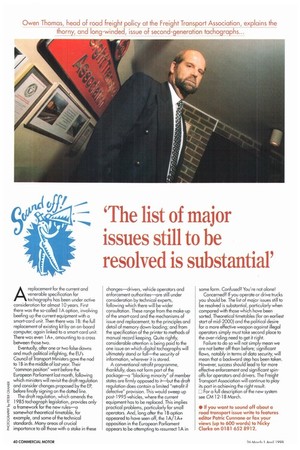Owen Thomas, head of road freight policy at the Freight
Page 42

If you've noticed an error in this article please click here to report it so we can fix it.
Transport Association, explains the thorny, and long-winded, issue of second-generation tachographs...
The list of major issues still to be resolved is substantial'
Areplacement for the current and venerable specification for tachographs has been under active consideration for almost 10 years. First there was the so-called lA option, involving beefing up the current equipment with a smart-card unit. Then there was 1B: the full replacement of existing kit by an on-board computer, again linked to a smart-card unit. There was even 1A+, amounting to a cross between those two.
Eventually, after one or two false dawns and much political infighting, the Ell's Council of Transport Ministers gave the nod to 1B in the middle of last year. Their "common position" went before the European Parliament last month, following which ministers will revisit the draft regulation and consider changes proposed by the EP, , before finally signing on the dotted line. ,.' The draft regulation, which amends the
.1985 tachograph legislation, provides only
a framework for the new rules—a i' .somewhat theoretical timetable, for
6 example, and some of the technical 01'2 standards. Many areas of crucial importance to all those with a stake in these
changes—drivers, vehicle operators and enforcement authorities—are still under consideration by technical experts, following which there will be wider consultation. These range from the make-up of the smart-card and the mechanisms of issue and replacement, to the principles and detail of memory down-loading; and from the specification of the printer to methods of manual record keeping. Quite rightly, considerable attention is being paid to the one issue on which digital tachographs will ultimately stand or fall—the security of information, wherever it is stored.
A conventional retrofit programme, thankfully, does not form part of the package—a "blocking minority" of member states are firmly opposed to it—but the draft regulation does contain a limited "retrofit if defective" provision. This would sweep up post-1995 vehicles, where the current equipment has to be replaced. This implies practical problems, particularly for small operators. And, long after the 18 option appeared to have seen off, the 1A/1A+ opposition in the European Parliament appears to be attempting to resurrect 1A in some form. Confused? You're not alone!
Concerned? If you operate or drive trucks you should be. The list of major issues still to be resolved is substantial, particularly when compared with those which have been sorted. Theoretical timetables (for an earliest start of mid-2000) and the political desire for a more effective weapon against illegal operators simply must take second place to the over-riding need to get it right.
Failure to do so will not simply mean we are not better off than before; significant flaws, notably in terms of data security, will mean that a backward step has been taken. However, success should lead to far more effective enforcement and significant spinoffs for operators and drivers. The Freight Transport Association will continue to play its part in achieving the right result. 1.] For a full description of the new system see CM 12-18 March.
• If you want to sound off about a road transport issue write to features editor Patric Cunnane or fax your views (up to 600 words) to Nicky Clarke on 0181 652 8912.




































































































